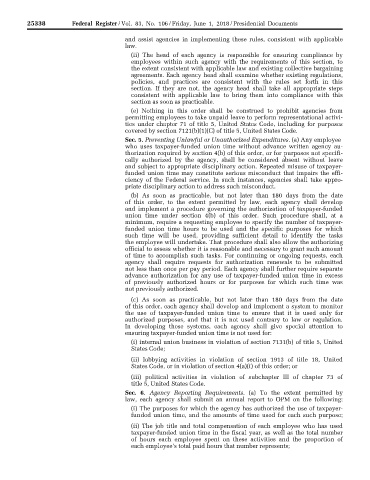Page 693 - Trump Executive Orders 2017-2021
P. 693
25338 Federal Register / Vol. 83, No. 106 / Friday, June 1, 2018 / Presidential Documents
and assist agencies in implementing these rules, consistent with applicable
law.
(ii) The head of each agency is responsible for ensuring compliance by
employees within such agency with the requirements of this section, to
the extent consistent with applicable law and existing collective bargaining
agreements. Each agency head shall examine whether existing regulations,
policies, and practices are consistent with the rules set forth in this
section. If they are not, the agency head shall take all appropriate steps
consistent with applicable law to bring them into compliance with this
section as soon as practicable.
(e) Nothing in this order shall be construed to prohibit agencies from
permitting employees to take unpaid leave to perform representational activi-
ties under chapter 71 of title 5, United States Code, including for purposes
covered by section 7121(b)(1)(C) of title 5, United States Code.
Sec. 5. Preventing Unlawful or Unauthorized Expenditures. (a) Any employee
who uses taxpayer-funded union time without advance written agency au-
thorization required by section 4(b) of this order, or for purposes not specifi-
cally authorized by the agency, shall be considered absent without leave
and subject to appropriate disciplinary action. Repeated misuse of taxpayer-
funded union time may constitute serious misconduct that impairs the effi-
ciency of the Federal service. In such instances, agencies shall take appro-
priate disciplinary action to address such misconduct.
(b) As soon as practicable, but not later than 180 days from the date
of this order, to the extent permitted by law, each agency shall develop
and implement a procedure governing the authorization of taxpayer-funded
union time under section 4(b) of this order. Such procedure shall, at a
minimum, require a requesting employee to specify the number of taxpayer-
funded union time hours to be used and the specific purposes for which
such time will be used, providing sufficient detail to identify the tasks
the employee will undertake. That procedure shall also allow the authorizing
official to assess whether it is reasonable and necessary to grant such amount
of time to accomplish such tasks. For continuing or ongoing requests, each
agency shall require requests for authorization renewals to be submitted
not less than once per pay period. Each agency shall further require separate
advance authorization for any use of taxpayer-funded union time in excess
of previously authorized hours or for purposes for which such time was
not previously authorized.
(c) As soon as practicable, but not later than 180 days from the date
of this order, each agency shall develop and implement a system to monitor
the use of taxpayer-funded union time to ensure that it is used only for
authorized purposes, and that it is not used contrary to law or regulation.
In developing these systems, each agency shall give special attention to
ensuring taxpayer-funded union time is not used for:
(i) internal union business in violation of section 7131(b) of title 5, United
States Code;
(ii) lobbying activities in violation of section 1913 of title 18, United
States Code, or in violation of section 4(a)(i) of this order; or
(iii) political activities in violation of subchapter III of chapter 73 of
title 5, United States Code.
Sec. 6. Agency Reporting Requirements. (a) To the extent permitted by
sradovich on DSK3GMQ082PROD with PRES DOCS VerDate Sep<11>2014 13:05 May 31, 2018 Jkt 000000 PO 00000 Frm 00004 Fmt 4790 Sfmt 4790 E:\FR\FM\01JNE1.SGM 01JNE1
law, each agency shall submit an annual report to OPM on the following:
(i) The purposes for which the agency has authorized the use of taxpayer-
funded union time, and the amounts of time used for each such purpose;
(ii) The job title and total compensation of each employee who has used
taxpayer-funded union time in the fiscal year, as well as the total number
of hours each employee spent on these activities and the proportion of
each employee’s total paid hours that number represents;

